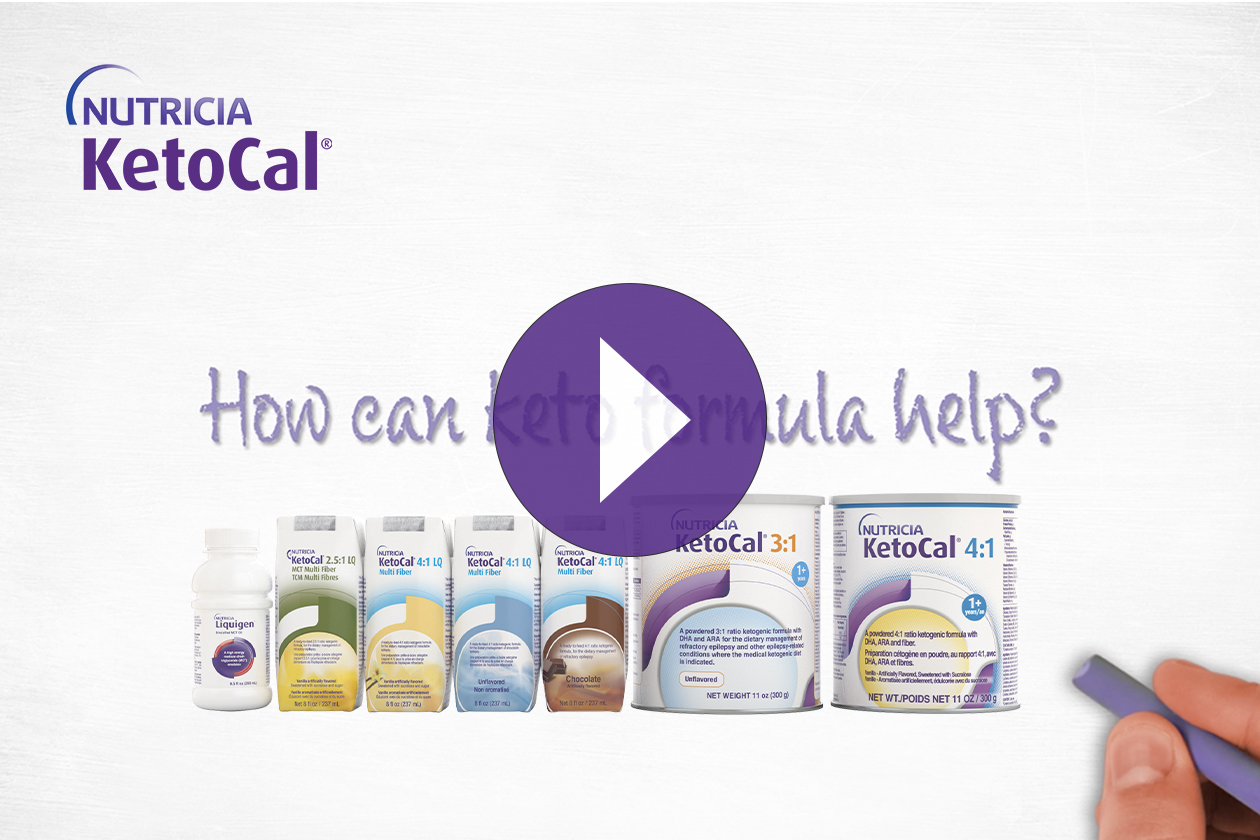Over the past few blogs, we’ve been highlighting topics from our medical ketogenic diet educational videos. If you missed the previous blogs and want to catch-up, here are links for quick access:
- Short Video Series Introduction: The Basics of a Medical Ketogenic Diet Explained
- Short Video Series: Part 1 – Medical Ketogenic Diet Basics
- Short Video Series: Part 2 – Medical Ketogenic Diet Variations and How to Manage
Our last blog in this series is all about how to use KetoCal® with a medical ketogenic diet. Our ketogenic dietitian friends have created 3 short videos to help you understand how keto formula can help, preparing KetoCal and how to adjust the ketogenic diet ratio when using KetoCal.
KetoCal is a ketogenic formula designed for drug-resistant epilepsy (also referred to as refractory or intractable epilepsy) to help with seizure control. In part 1 of our video series, we learned that medical ketogenic diets are calculated by using a ratio of fat to protein and carbohydrates combined. KetoCal is available in 3 different ratios, 2.5:1, 3:1 or 4:1. Whether you are tube-fed or eat by mouth, KetoCal provides the same ratio and a balance of nutrients every time, so you don’t have to worry about calculating each meal to get the right ratio.
Ketogenic dietitian, Robyn Blackford, RDN, LDN shares more ways KetoCal can help in this short video.
How Can Keto Formula Help
Video Transcript:
Hi! I’m Robyn! I’m a registered dietitian. I’m going to talk to you about how medical ketogenic formula, like KetoCal, can help whether you or your loved one are tube-fed or eating by mouth.
If you’re tube fed, it’s helpful because it is minimal work to prepare the formula since it comes in a ready-to-feed or a powder that is mixed with water. It is also already in the right ratio, which will give you peace of mind that you don’t have to mix things together to get a certain ketogenic ratio.
If you’re eating by mouth, it can be great as an easy meal or snack, when you do not have time to cook. It is also helpful when travelling to get the correct ketogenic ratio without the need to weigh or measure food portions. One study showed that it may help with diet compliance long-term when patients started the modified Atkins diet with KetoCal.
Medical ketogenic formulas provide complete nutrition, meaning fat, protein, limited carbohydrates, vitamins, minerals and most formulas also contain fiber.
Whether you are tube-fed or eat by mouth, it’s very beneficial to have something on hand that is quick and easy!
Thanks for watching! Be sure to check our other videos on the medical ketogenic diet.
KetoCal - Medical Ketogenic Diet Formulas for Epilepsy
In addition to a variety of ratios, KetoCal also comes in a variety of flavors and formats. Our KetoCal family includes:
- KetoCal 4:1 LQ – a ready-to-feed liquid available in your choice of unflavored, vanilla, or chocolate flavors
- KetoCal 4:1 - powder that you mix with water
- KetoCal 3:1 – powder that you mix with water
- KetoCal 2.5:1 LQ – a ready-to-feed liquid available in a vanilla flavor
Check out our short video on how to prepare KetoCal to watch a demonstration of how easy it is to mix KetoCal powder.
Adjusting Ketogenic Ratio When Adding Other Ingredients to KetoCal
For some individuals, your ketogenic dietitian may recommend a non-standard ketogenic ratio, such as 3.2:1 or 3.5:1. KetoCal formula can still be a great option. Zahava Turner, RD, CSP, LD explains in our final video, how to adjust the ketogenic diet ratio when adding other ingredients to KetoCal.
Video Transcript:
Hi! I’m Zahava. I’m a registered dietitian. Today I’m going to talk to you about adjusting the ratio when adding other ingredients to KetoCal.
Sometimes you may not always be on a standard ratio like [the ratios] the formulas come in. You might have to adjust it based on what your dietitian tells you to do by adding extra fat, protein or carbohydrate to a prepared formula like KetoCal. The steps will all still be pretty close though.
You will still weigh out whatever ingredient you are adding to your formula first. Here we have Liquigen®. It is an emulsified medium chain triglyceride oil which is good for patients on the ketogenic diet. You could also add a protein powder. Weigh them out separately before mixing them together in case you aren’t exact in your measurement of the product. That way you don’t waste any of the formula. If it is the powder, make sure you are using warm water, between 113-122 degrees Fahrenheit to ensure that the powder dissolves all the way. If adding to liquid KetoCal products, you would add it to the liquid and mix it together.
To measure the product, first turn on your scale and make sure it is zeroed out by pressing the “Zero” or the “Tare” button. Then place your bottle, jar or anything you are using to store or mix the formula on your scale. Push “Zero” or “Tare” again, so that the scale is reading “Zero” and is ready to record the grams of powdered or liquid modular you are weighing.
For this recipe we are going to measure out
- 20 grams of Liquigen and
- 220 grams KetoCal 4:1 LQ to make a typical 8 ounce fluid bottle.
If you are using a powdered modular (such as powdered protein) you would do the same to measure out the protein then add to your liquid product, or water, and add your KetoCal powder or whatever else you need to add. Be sure to measure each ingredient separately and then mix them all together.
You can use a resealable bottle or shaker bottle to help mix the formula. You can prepare formula per bottle or prepare a large batch for the entire day and then keep it in the fridge until the next feed.
KetoCal can be kept in the fridge for up to 24 hours. After 24 hours, the formula should be discarded, and a new batch should be prepared.
If using KetoCal formula for tube feeding, be sure to flush the feeding tube with lukewarm water (approximately 98 degrees Fahrenheit or 37 degrees Celsius) to make sure any remaining formula is cleared from the tube.
Thanks for watching! Be sure to check out our other videos on the medical ketogenic diet.
KetoCal® is a medical food for the dietary management of drug-resistant epilepsy and must be used under medical supervision.
Copyright 2024 Nutricia North America. All rights reserved. Brought to you by Nutricia North America.

